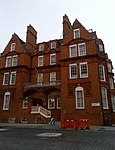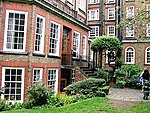High Commission of Tonga, London
Buildings and structures in the City of WestminsterDiplomatic missions in LondonLondon building and structure stubsLondon stubsTonga and the Commonwealth of Nations ... and 3 more
Tonga stubsTonga–United Kingdom relationsUnited Kingdom and the Commonwealth of Nations

The High Commission of Tonga in London is the diplomatic mission of Tonga in the United Kingdom. Tonga and the United Kingdom established diplomatic relations in June 1970 after the Treaty of Friendship and Tonga's protection status ended.The Tongan High Commission is located on 36 Moyneux Street in Marylebone, London.
Excerpt from the Wikipedia article High Commission of Tonga, London (License: CC BY-SA 3.0, Authors, Images).High Commission of Tonga, London
Molyneux Street, London Marylebone
Geographical coordinates (GPS) Address Nearby Places Show on map
Geographical coordinates (GPS)
| Latitude | Longitude |
|---|---|
| N 51.51807 ° | E -0.1643 ° |
Address
Molyneux Street 35
W1H 5HP London, Marylebone
England, United Kingdom
Open on Google Maps







